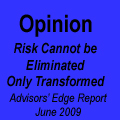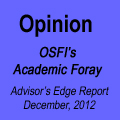The British government indicated interest in a debt security that would convert to capital in times of stress, as discussed in the post HM Treasury Responds to Turner Report.
Such an instrument is of interest to preferred share investors since preferred shares are the natural basis for the first wave of such instruments. For example, a preferred share issued at a time when the bank’s common equity was trading at $50 might have a provision that, should the common price fall below $25 for a specific period of time (say, the Volume Weighted Average Price for any given period of twenty consecutive trading days), then the preferred would automatically convert into common, receiving its full face value of common valued at $25 per share.
Now William C Dudley, President and Chief Executive Officer of the Federal Reserve Bank of New York, has delivered a speech titled Some Lessons from the Financial Crisis indicating support for the general idea:
the introduction of a contingent capital instrument seems likely to hold real promise. Relative to simply raising capital requirements, contingent capital has the potential to be more efficient because the capital arrives as equity only in the bad states of the world when it is needed. It also has the benefit of improving incentives by creating two-way risk for bank managements and shareholders. If the bank encounters difficulties, triggering conversion, shareholders would be automatically and immediately diluted. This would create strong incentives for bank managements to manage not only for good outcomes on the upside of the boom, but also against bad outcomes on the downside.
Conceptually, contingent capital instruments would be debt instruments in “good” states of the world, but would convert into common equity at pre-specified trigger levels in “bad” states of the world. In principle, these triggers could be tied to deterioration in the condition of the specific banking institution and/or to the banking system as a whole.
There are many issues that would need to be worked out regarding how best to design such instruments, including how to determine their share of total capital as well as how to configure and publicly disclose the conversion terms and trigger. But, in my view, allowing firms to issue contingent capital instruments that could be used to augment their common equity capital during a downturn may be a more straightforward and efficient way to achieve a countercyclical regulatory capital regime compared to trying to structure minimum regulatory capital requirements (or capital buffers above those requirements) that decline as conditions in the financial sector worsen.
So what might such a contingent capital instrument look like? One possibility is a debt instrument that is convertible into common shares if and only if the performance of the bank deteriorates sharply. While, in principal, this could be tied solely to regulatory measures of capital, it might work better tied to market-based measures because market-based measures tend to lead regulatory-based measures. Also, if tied to market-based measures, there would be greater scope for adjustment of the conversion terms in a way to make the instruments more attractive to investors and, hence, lower cost capital instruments to the issuer. The conversion terms could be generous to the holder of the contingent capital instrument. For example, one might want to set the conversion terms so that the debt holders could expect to get out at or close to whole – at par value. This is important because it would reduce the cost of the contingent instrument, making it a considerably cheaper form of capital than common equity.
Consider the advantages that such an instrument would have had during this crisis. Rather than banks clumsily evaluating whether to cut dividends, raise common equity and/or conduct exchanges of common equity for preferred shares and market participants uncertain about the willingness and ability of firms to complete such transactions and successfully raise new capital, contingent capital would have been converted automatically into common equity when market triggers were hit.
He also had some things to say about dividends:
In times of stress, banks may have incentives to continue to pay dividends to show they are strong even when they are not. This behavior depletes the bank’s capital and makes the bank weaker. To correct this shortcoming in our system, we should craft policies that either incent or require weak and vulnerable firms to cut dividends quickly in order to conserve capital. This would introduce a dampening mechanism into our system.
I don’t know about this. It gives a lot of discretion to the regulators – or requires the imposition of rules that will of necessity be so complex as to be useless during the next crisis – and the regulators have shown they are not up to the task.
Now that the moment has passed, they are getting tough on banks that are already mostly nationalized, but throughout the crisis they have routinely approved the redemption of sub-debt, which is particularly galling since the sub-debt was virtually all resetting to yields less than that required to issue new senior debt.
It would have been the easiest thing in the world for regulators to have announced that the required approval for subordinated debt redemption would be withheld in cases where this would have reduced the total capital ratio below – say – 12%. Such an announcement would have been transparent, recognized as being arguably justified and not to be considered a regulatory judgement on the soundness of any particular bank.
But they muffed it, rubber-stamped their approvals and blew their credibility.









































































































